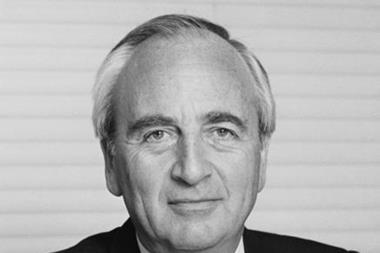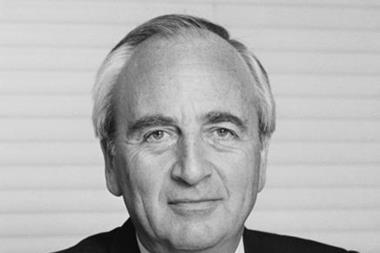Battling compensation culture, championing proportionate and rationonal measures – the rhetoric behind Lord Young’s health and safety review is music to most insurers’ ears. But, asks Katie Puckett, does he really stand a chance of making it happen?
If a conker falls on someone’s head in the forest when nobody is there, and they believe they’re entitled to compensation, does that mean there’s a compensation culture – or just a perception of one? That’s one question that remains unresolved by Lord Young of Graffham’s review of the UK’s health and safety laws, published last month.
While Young is careful to speak only of a “pernicious” fear of litigation, and even includes a helpful annex debunking tabloid scare stories, prime minister David Cameron’s tub-thumping introduction condemns “a damaging compensation culture … with the spectre of lawyers only too willing to pounce with a claim for damages on the slightest pretext”.
Whether the threat of litigation is real or imagined, there appears to be no doubt in either man’s mind that it is constraining businesses and individuals, and that the UK’s broken health and safety system badly needs a dose of “common sense”.
Particularly welcome for insurers are Lord Young’s determination to cut the disproportionate costs of personal injury claims and his unequivocal endorsement of Lord Justice Jackson’s reforms of referral fees, after-the-event insurance premiums and success fees. He also recommends extending the simplified fixed-cost process for low-value motor claims to employers’ liability and public liability claims below £10,000, and raising the threshold for motor claims to £25,000, which would constrain costs for all but a tiny minority of the more complex cases.
And he demands a crackdown on aggressive advertising campaigns by claims management companies and solicitors. In short, the report is music to insurers’ ears. But as Groupama’s head of large and complex loss, Karl Parr, says: “As an industry, we’ve been here before, where recommendations are chipped away under pressure from the claimant lobby. We need to understand the detail of how it's going to happen.”
Backed from the top
Optimists point out that the review was commissioned by Cameron while he was still in opposition, and fits snugly with the government’s agendas on cutting public spending, by reducing the burden of compensation claims on public bodies such as the NHS, and supporting Cameron’s cherished ‘Big Society’ by removing the shadow of liability from potential volunteers. Lord Young was given a platform to launch the report at the Conservative conference, they add, and he is staying on to see his proposals are implemented within a very ambitious 18-month timescale.
For law firm Keoghs’ director of market affairs, Steve Thomas, one of the most significant parts of the report is the prime minister’s foreword. “It’s saying that there’s not going to be a great deal of discussion,” he says. “The language is very much ‘we’re going to do this’, not just put it under discussion. My experience is that you never get everything you want, but I think there is a will there. There’s a sense that it’s going to happen. I've been involved in lobbying on this for seven or eight years and I'm probably more positive now than I ever have been.”
But despite the ringing endorsement from government, there is still considerable uncertainty over how exactly Lord Young could effect this return to common sense. His recommendations cut across many government departments and are subject to a number of other reports and ongoing consultations.
Some, notably Jackson’s reform of fees for personal injury claims, require primary legislation; others are rather more vague and not easily formulated into laws at all.
For example, both Young and Cameron want to ensure that volunteers are not liable when well-intentioned acts go wrong, referred to as the ‘Good Samaritan clause’. In fact, this provision is already in law, in section 1 of the Compensation Act 2006, which protects people engaged in “desirable activities”, but has rarely been used in court. Thomas suggests the Act could be “beefed up”, but that there is always likely to be room for argument. “It’s such a difficult one to pin down,” he says. “It depends how they word it, but it will always boil down to the merits of each case.”
Lord Young is also clearly dismayed by the level and nature of advertising by claims companies, which he believes fuels the idea of a compensation culture, and he has written to the Advertising Standards Authority (ASA), the Claims Management Regulator and the Solicitors Regulation Authority. He suggests the ASA should enforce the social responsibility aspect of its code, a rather grey area much open to interpretation.
Extending the Ministry of Justice’s portal for low-value motor claims is more clear cut – a case of changing the Civil Procedural Rules. This would be good news for insurers, which lobbied for it to apply much more widely in the first place. “It’s early days, but so far the process does seem to be curtailing costs and deterring speculative claims – anecdotally, the numbers of claims is down,” says Beachcroft partner and head of strategic litigation Andrew Parker.
AXA managing director of claims David Williams agrees: “We see some real improvements in attitudes, speed and costs through the Ministry of Justice process and portal, so extending that would be a great move, though you might have to look at timescales, as investigations are more difficult with public liability claims.”
Impossible task?
But this idea is meeting fierce resistance from claimant solicitors. A story in the Law Society Gazette after the report was published claimed that the Motor Accident Solicitors Society (Mass) and the Association of Personal Injury Lawyers (Apil) are investigating anecdotal evidence that insurers were “abusing” the new system.
Apil president Muiris Lyons says its members’ experiences are mixed, and they report between one in 10 and one in two cases falling out of the process. “We’d be concerned about extending the portal without a proper review of how it is working. It only came in April and there are still an awful lot of teething problems and issues behind the scenes: who owns it, who runs it, who owns the data.
“ We would like to see it run for at least a year and then a careful review to make sure it’s effective and does what it ought to do. We don't accept it should be rolled out before then.”
Meanwhile, insurers complain privately that solicitors are deliberately storing up claims and then overloading the system to make it more likely they will miss the deadline.
Even more controversial is Lord Young’s recommendation that the Jackson Review be implemented in full. “That’s probably the most significant part for us,” says QBE claims controller Jonathan Coatman. “It’s good to see more impetus given to it, although there’s still the danger that some of the features won’t make it onto the statute. We’re more hopeful than we were before.”
On the other hand, Groupama’s Parr points out that Young stops short of backing Jackson’s abolition or capping of referral fees. “We need to make sure that Jackson is not overtaken by the recommendations that Lord Young is making,” he says. “My concern is that payment of these referral fees is what drives a lot of the behaviour we see. If referral fees are still there, the lawyers need to recover those costs.”
As conditional fee arrangements and referral fees are already enshrined in the Access to Justice Act 1999, Jackson’s changes would require primary legislation. Lobbyists on all sides are gearing up in readiness for a Ministry of Justice consultation due any day now, and the Legal Services Board has an ongoing investigation of referral fees.
Parker also warns that there may be unintended consequences of the Legal Services Act 2007, which opens the door for alternative business structures for law firms. “You could end up with a ban on referral fees on one side of the page but permit alternative business structures on the other. That needs to be joined up.”
Many challenges ahead
Even if Lord Young’s recommendations do make it into law, they will still need the support of the judiciary to be enforced, adds Weightmans commercial insurance partner Peter Forshaw.
“A lot of litigation goes to court because there are discrepancies in the law and it comes down to the judiciary’s view of what parliament intended. The more clearly it is worded, the less likely it is to be challenged,” he says.
The report also includes a number of measures to streamline the burden of health and safety regulation on businesses, shifting the emphasis from eliminating all risk to taking a “rational, proportionate” approach. Lord Young criticises insurers for demanding that smaller businesses employ health and safety professionals to undertake complex risk assessments, and calls for a simplified checklist for low-hazard environments, such as shops and offices.
At Groupama, Parr denies that it is insurers who are imposing these regulations. “It is generated by the need to comply with legal requirements so that companies are not exposed and finding themselves liable because they haven't completed assessments and form-filling exercises.”
Nevertheless, the ABI says it is happy to work with Lord Young and has begun to develop a code of practice for the industry as he suggests. If the industry is unable to do so, Young says that legislation should be considered.
Allianz chief engineer Phil Wright says the UK has had a tendency to ‘gold plate’ minimum health and safety standards set by the EU, and there is considerable scope to streamline regulations. He also welcomes Lord Young’s recommendation that the UK work with other member states to provide a consistent approach for businesses operating in different countries.
“This report is a breath of fresh air, and it could be the seed for health and safety enforcers to get together. We do have a good health and safety record and we don’t want to water that down, but there is a difference between employers becoming reckless on one hand and getting rid of ‘bonkers conkers’ on the other.”
Fighting our cause
The industry’s health and safety experts will be watching closely for negative knock-on effects of Lord Young’s other recommendations. For example, current regulations require that accidents resulting in three days’ absence are reported to be Health and Safety Executive. Lord Young proposes extending this to seven days, as does a private members’ bill, which had its first reading in the House of Commons on 21 October.
But Garwyn divisional director of health and safety Mike Williamson says that many companies actually go further and record absences of just one day. “Companies see it as good business because it helps them drive down accidents in the workplace and time lost,” he says.
Changing the regulations now would render previous data comparisons useless, he adds. “More and more insurers are looking at these statistics because they find that claims statistics do not give them enough information. Any underwriter would rather have the wider picture. The claims picture can be completely different to the accident frequency rate.”
Whatever happens next, insurers may at least derive comfort from the fact that the government seems to be taking their concerns seriously. And as for whether there is a compensation culture, AXA’s Williams at least is in no doubt. “I think Cameron’s got it spot on. Sit down and watch all the adverts on daytime television and tell me there isn’t a compensation culture.”
Though the claimant lobby emphasises that numbers of claims have dropped, Williams points out that the number of people claiming injury per motor accident has risen from 1.2 to 1.6 over the last three years, a 33% increase.
“The adverts create this ‘have a go’, free-money mentality,” he says. “It’s pleasing to see Cameron being so blunt after the previous government preferred to talk it down. I’m going to pin this up in my office.” IT






































No comments yet